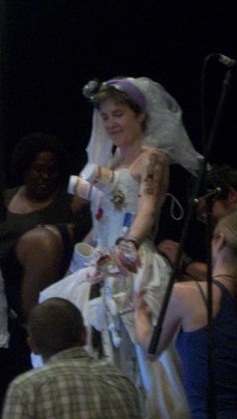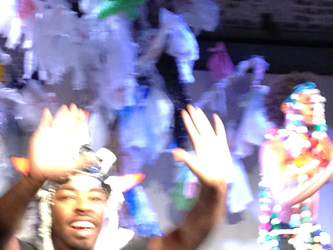“What is my heart
If you don’t want it?”
—(Sharon Dubiago: Hard Country)
Layer under sticky layer, redolent detritus, lift “history” carefully away, gloves on: Underworld by DeLillo, Garbage by Ammons, and under that Stevens, of course, his “…Man on the Dump,” noisily beating the medium (“The the”), amid the packaging from Eastern stimulants, strewn across Eliot’s “heap of broken images.” Under which (don’t try to lift “The Wasteland,” not alone, prod through it with a long stick) the high piles of treasure-filled ash composing the “mounds” of Dickens’ marvelous strange dense rich Our Mutual Friend. In that novel a man who appears to have been murdered (and buried) assumes a new identity in order to haunt the life he couldn’t have until love—and memory—show him how to return. Particle, wave, and scientist at once, the hero is both flesh and blood (as we say) and ghost, watching and testing those around him, and being tested himself. In some part easily legible as a book about the need to find real meaning(s) beyond all the seductive signs for value, Our Mutual Friend also reminds us that we each, precarious, exist on the unstable and uneasy line between life and death, significance and nonsense. Over that line, what Julia Kristeva called “the abject” is a source of energy, but perhaps everyone who survives a suicide attempt has a certain fondness for garbage? I could so easily...or uneasily, then, have become an “it” (corpse, object): something whose disposal is difficult, surrounded by taboos involving not only grief but a certain necessary disgust. Perhaps part of our contemporary obsession with the undead is the result of our unequaled production of waste, which—a figure for the soulless body overstaying its welcome or Capital itself—feeds on or drains us? Trash “makes an ethical claim on us,”1 reflects and beckons, asks us to come near, to search its secrets, to learn—by looking—not only about the past but about our future. Here is what has been rejected and thrown out (where there is no “out”): here is what we will be also, body-as-object, unnecessary, disposable.
Under those shifting layers, keep digging, phew, Swift’s bitter “Inventory” of horrors—in “The Lady’s Dressing Room”—ending in celebration: “Such order from Confusion Sprung, / Such gaudy Tulips raised from Dung.” Torn scraps of ephemera from the desk of Yeats lie scattered over that mess: address book (“…Love has pitched his mansion in / The place of excrement”) and to-do list (“I must lie down where all the ladders start / In the foul rag and bone shop of the heart”). At the edge of the edge the “shop” (both verb and noun), reintroduces the great idea of the return: where the worthless comes back as valuable. In the image of the “clue,” at the site of the birth of the Detective Novel, we have the perfect symbol of this return: a little nothing turned to something by attention. Such recyclings will be one of the great themes of Modernism as it (re)turns into Post-Modernism: Duchamp and Cornell model (as does the work of Joan Tanner) the way in which, cut loose of the idea of the useful, a constraining gaze that regulates meaning, the everyday returns first as garbage and then as art, estranged and urgently evocative. In certain works by Magritte, or collages by Picasso, a frantic beating on the (“The the”) question of representation messes with and makes audible reality’s attempts to echolocate itself in some order, in us. While disgust and avoidance appear to be basic and biological reactions “the particular form they take is culturally shaped and acquired through a long process of training,” as Heather Rodgers notes (citing Raymond Geuss).2 Sharon Dubiago’s questioning of desire’s work in determining identity resonates in a culture in which privatized prisons and underfunded “homeless shelters” (or freeway underpasses) serve as dumping grounds for the unstable, unlucky and unwanted. What Joan Tanner does with her glove makes failure, vulnerability, work, age, loss and resiliency come forward stripped of easy “humanist” sentimentality. I hold Tanner’s work up against a piece by another artist (a darling of the Academics): the fragile cast of a disembodied but jacketed arm of a businessman or plainclothes police officer extending a tightly closed hand. Displayed on the museum’s wall, lighting makes the spikey letters spelling “Clench” legible as they emerge from the (wait for it) clenched fingers. It’s an object that—as Robert Wilson said of contemporary mainstream theatre—keeps asking if you “get it,” and insisting that you don’t. Tanner’s work is free not only from such didacticism but from that didacticism’s dark side: the effort to solicit sympathy for the oppressor and impose an extraordinarily superficial reading of the fist.
“Now!” In the early light I am shaking my love awake because I’ve just seen—from the window of our second story apartment in Queens—somebody setting a perfectly good wooden bookcase in the dumpster: “Hurry!” Under which sepia-stained and somewhat fragile moment from late in the last century lie memories of childhood visits to the dump, and family outings to thrift stores and auctions and estate sales: all the long lessons in the importance of getting a “bargain,” which were also lessons in learning to see the quality of things, no matter where they were, how they’d been treated, or what the price tag said. Being able to spot the real white mink jacket (ten dollars) on the “costume” rack at The Rag and Bone Shoppe or picking up the pair of Christian LouBoutin pumps (three dollars and forty-nine cents) at a Goodwill makes me feel like I’m the only one wearing night-vision goggles in a very murky situation, though I understand that what I find has everything to do with what I care about which is to say what I know which is to say my training. I’d done the research that store owners and employees hadn’t done or couldn’t: I know how real fur feels, and what LouBoutin is currently worth. But climate “change,” and catastrophe, reveal the absurdity of my information: knowing how to make contaminated water potable is clearly going to matter a whole hell of a lot more than a memorized catalogue of shoe designers. Stamina and shelter, fresh water and edible food, friends (and the kindness of strangers), and care, most of all, for the eco-systems supporting the life forms we depend on and love—these should have been my study all along.
The creation of the collection you’re about to enter (or, you have already entered) was over-determined, though without the kindness of friends and strangers it wouldn’t exist. Were I to dedicate it I might send it off in several directions: first to Brenda Ijima, whose work is an inspiration and whose blunt insistence (in a casual conversation) that Tarkovsky’s Stalker needed, badly, to be remade proved enlightening. And then to Jorie Graham, whose capacious, generous, active attention to the world was once dismissed (by some nefarious fool at the Times) as like unto that of a “bag lady.” That Reagan-era insult and pointed effort to shame us (all) into inattention if not heartlessness is worth a distanced examination and strong distrust. To Marthe Reed for her unflagging care for the unfolding ecological tragedies of South Louisiana, and Anne Waldman—whose miraculous, expansive vision the critics seem barely to be able to deal with… And to you, reading this.
Under everything, now, Gertrude Stein, for me, under everything: her focus on the deictic, on doggerel, on the throwaway phrase, and her description (in Three Lives) of love’s way of turning the attention to what would otherwise be ignored. Bedrock, this author a friend had to insist I read, as (and this is true of Mina Loy, H.D., and Laura Riding Jackson) her works were not on any syllabus in all my long years at school. What matters most of all is to see how flexible and arbitrary value is—in order to intervene, in order to live. In Stein’s turn away from the noun, in her emphasis on verb and preposition, in her description of the transformed lover, opened by happiness, who “loved everything that moved and that was still, and that had color, and beauty, and real being,” in her love for attention itself, I see a call to a radical inclusivity and the falling of the usual orders, frameworks, and hierarchies. On that foundation, closer to us, Harryette Mullen’s S*PERM**K*T, Brenda Coultas’ A Handmade Museum, Martha Rosler’s The Bowery in Two Inadequate Descriptive Systems, Claudia Rankine’s Don’t Let Me Be Lonely and her amazing play, Provenance of Beauty, Evelyn Reilly’s Styrofoam, Carol Snow’s Placed, Joyelle McSweeney’s work with the “necro-pastoral” and Alice Notley’s Culture of One, among her other great books, and then the extraordinary work of Brenda Hillman. Always, always—as a touchstone—Hillman’s “Styrofoam Cup.”
What is it you think you shouldn’t write about? What is it you feel like you’re not supposed to say? Push on those boundaries… Those sentences pretty much sum up what I want to say to writers, right now—and they make up what little I can find of the notes for the class on “Trash” I taught at Naropa in the summer of 2011, the second summer after BP’s blow-out (and belated, poisonous, clean-up) polluted the Gulf. Actually the group of brilliant, gifted students at Naropa taught me about courage and commitment. It’s, so often, the little, invisible, agreements—politeness, unquestioning agreement with received ideas about value and quality, the enforced complicity which is the price of passing—that gives the nod to silence, and death. What I admire in the works in this issue is their willingness to face and dwell in and with uneasy objects and what Sianne Ngai called Ugly Feelings. I love the sense of fragility, the almost-didn’t-exist-at-all sense informing some of these gestures and pieces. It would have been so easy to do or say something else, something more acceptable… At Naropa I put on the wedding gown the community had—at my request—covered in trash over the course of the week…and felt what it was to wear that stinking, fly-attracting, heavy weight…
There’s shame, disgust, and grief in our chosen subject: it took a certain something to send work to ‘the Trash Issue,’ and I’m really grateful to everyone who sent us poems to look at—whether or not we were, as we say, able to “use” all the marvelous pieces we got. And I’m grateful, beyond words, to Joshua’s vision, Afton’s artistry and hard labor, and Angela’s good energies, dedication, and sheer genius.
At the New Orleans “fringe fest” in late November I caught Bonny McDonald’s wonderful performance piece, Sacred Waste, a work which (as its creator notes):
examines the geologic history and ecologic impacts of single-use plastics…, elevating plastic waste to an object of worship [in order to] defamiliarize the detritus of discard culture, forcing audiences to reckon with everyday rituals of convenience and pervasive ideologies of abundance which undergird the U.S. consumer practices. The…cast wears intricate costumes made from plastic waste, amounting to about 4,000 plastic bags and 6,000 plastic bottle caps, representing the amount of such items U.S. consumers alone throw away every two seconds.
Including mock-evangelical lectures on the beauty of “the holy styrenes,” as well as wild dancing, ecstatic debris praise, fervent condemnations of recycling and other instances of the Carnivalesque, Sacred Waste compels audience participation and operates on the edge where difficult information becomes positive energy. Where the truth, indeed, sets us free.
Where we’re living.
Notes
1Knechtel, John and Gay Hawkins. Trash. Massachusetts Institute of Technology and Alphabet City Media, 2007. 57. Print.
Return to Reference.
2Knechtel, John and Heather Rodgers. Trash. Massachusetts Institute of Technology and Alphabet City Media, 2007. 124. Print.
Return to Reference.

